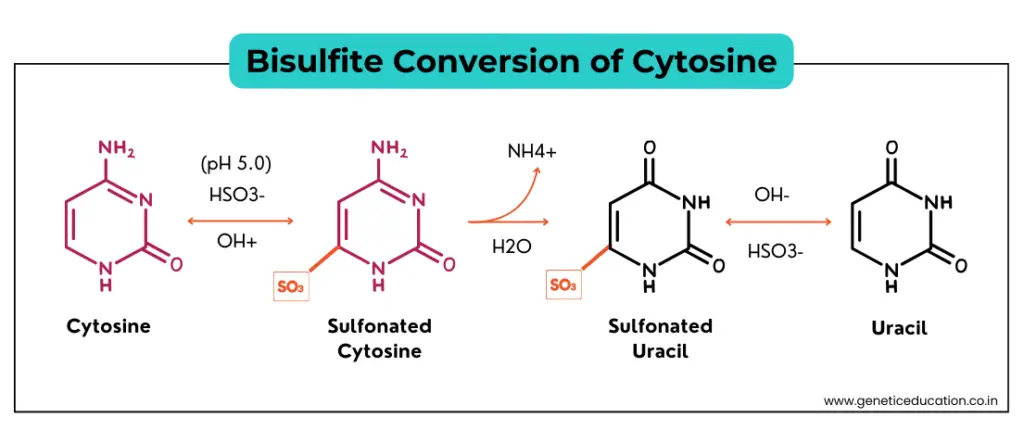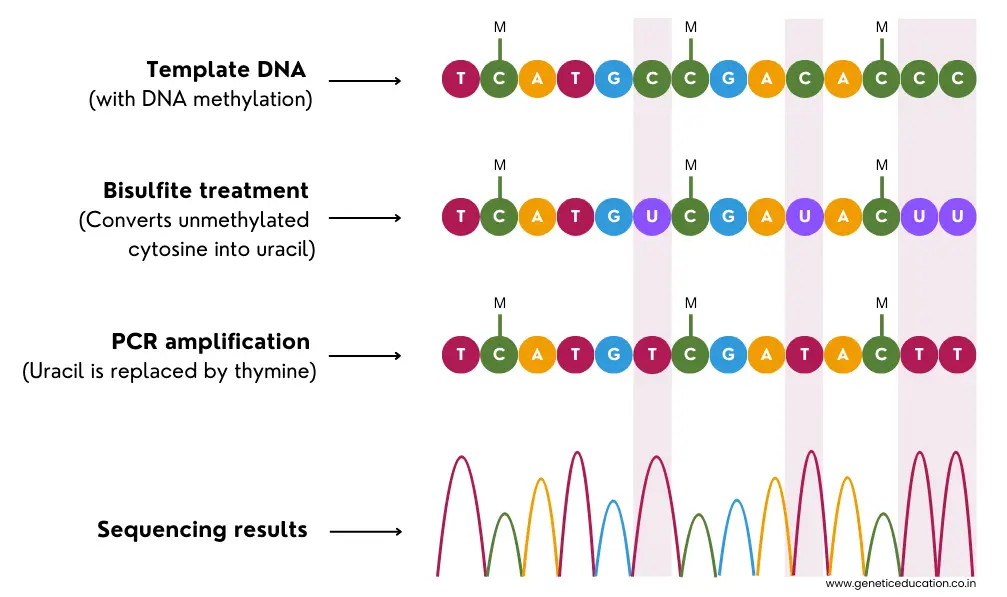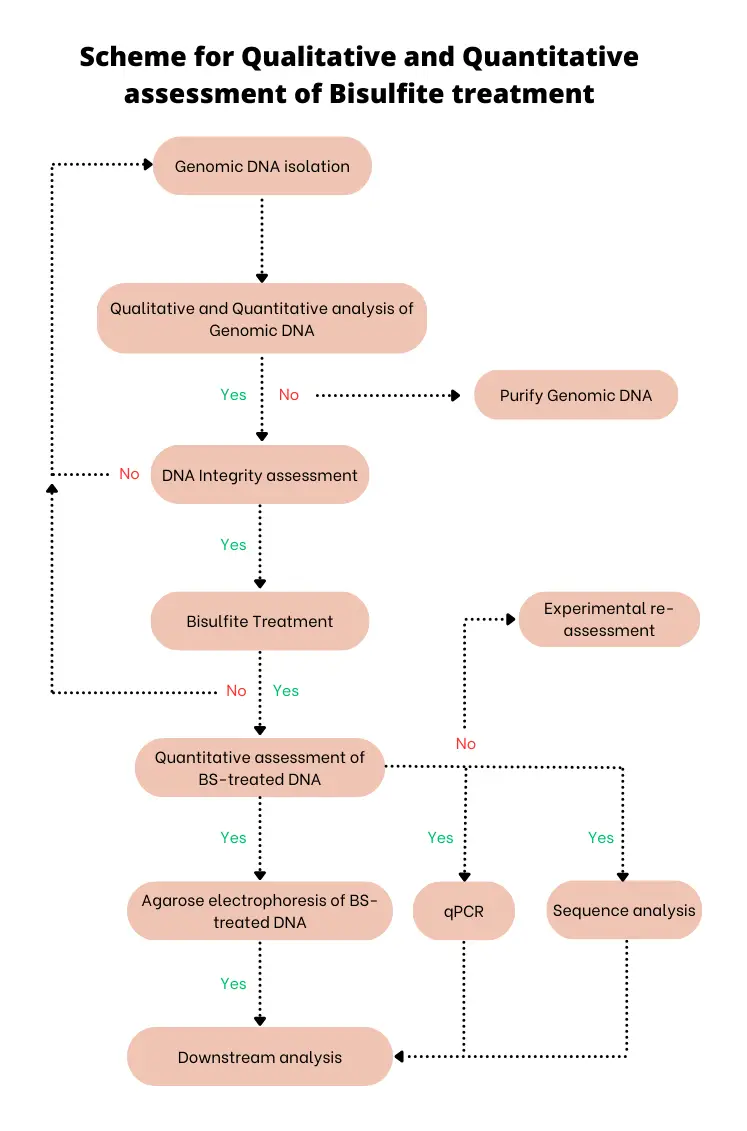“This article is an extensive guide for bisulfite treatment of DNA. Learn the concept, principle, mechanism, process, protocol, applications and limitations.“
DNA methylation is a significantly important biological event that switches on or off a gene. Particularly occurring on the DNA cytosine bases, methylation when adding a methyl group to DNA, makes a gene inactive.
Due to this the polymerase can’t access the recognition sequence and fails to synthesize the gene. So methylation analysis helps us understand the gene expression and regulation event for a gene or an entire genome.
A technique known as bisulfite conversion has been mentioned as a gold standard for DNA methylation analysis. Bisulfite conversion as a pre-treatment step is employed in Methylation-specific PCR and Methylation sequencing.
So what exactly the bisulfite conversion of DNA is and how to do it?
This article is a complete guide for DNA bisulfite treatment. I am explaining the history, concept, principle, mechanism, process, protocol, advantages, limitations and applications.
Stay tuned.
Key Topics:
What is bisulfite conversion of DNA?
A bisulfite treatment or conversion is a molecular biology reaction used to convert some of the DNA bases, for instance, Cytosine into some other ‘base form.’ It, resultantly, allows methylation study.
The process of bisulfite treatment using sodium bisulfite was first discovered by Hayatsu et al. and Shapiro et al. in 1970. However, its application was introduced in 1992. Frommer et al. (1992) introduced a sequencing technique using bisulfite conversion.
The present assay has been used to investigate DNA methylation status for a gene. We’ll understand the concept first.
Methylation is an epigenetic tag. It occurs in the Cytosine DNA bases. It is usually noted in the gene promoter regions rich in Cytosine and Guanine (known as CpGs). Thus, methylation is extensively reported in the CpG island regions of the genome.
So, gene promoters are affected by the ‘tag’ here, meaning, whenever an enzyme tries to find out a gene promoter to initiate gene expression, it fails!
Meaning, that a gene can’t be expressed if there is a methylation event in the CpG-rich promoter region. Bisulfite conversion can identify such methylation activities.
Principle

When the DNA sample is treated with sodium bisulfite, the unmethylated cytosines are converted into the uracil. Later on, the uracils are converted into Thymine using a PCR amplification.
Now, how the methylated and unmethylated cytosines are distinguished?
During methylation, a methyl group is added to the C5 carbon of the cytosine ring. The reaction is catalyzed by an enzyme DNMT (DNA methyltransferase). As aforesaid, it prevents further enzymatic processing by blocking the pathway.
To distinguish the methylated bases from non-methylated ones, bisulfite treatment is carried out. In the presence of the bisulfite reagent, the non-methylated cytosines convert into another base form, that is uracil.
Further conversion of uracil into Thymine by PCR amplification can help distinguish between methylated and non-methylated cytosines. Let’s see the molecular mechanism behind it.
Molecular Mechanism
At a molecular level, the whole reaction is completed in three different steps, shown in the diagram below- sulfonation, deamination and desulfonation.

Sulfonation:
Sulfonation is the initial step in bisulfite conversion, where sodium bisulfite (NaHSO3) reacts with cytosine residues in DNA under slightly acidic conditions. In this step, bisulfite (HSO3-) acts as a nucleophile, attacking the C5 carbon of the Cytosine ring.
The nucleophilic attack leads to the formation of a covalent adduct between bisulfite and cytosine, resulting in the formation of a sulfonated cytosine intermediate.
This sulfonation reaction is critical for subsequent steps in the bisulfite conversion process and serves as the basis for distinguishing between methylated and unmethylated cytosine residues.
Cytosine (C) + Bisulfite (HSO3-) → Cytosine sulfonate intermediate
Deamination:
Deamination is the second step in bisulfite conversion, where unmethylated cytosine residues undergo chemical transformation into sulfonated uracil.
Under the conditions of bisulfite treatment, the sulfonated-cytosine intermediate undergoes deamination, resulting in the removal of the amino group (-NH2) from the cytosine base.
The removal of the amino group converts sulfonated cytosine into sulfonated uracil. Methylated cytosine residues, which have a methyl group (-CH3) attached to the C5 carbon, are not susceptible to deamination and remain unchanged during this step.
Deamination selectively targets unmethylated cytosine residues, distinguishing them from methylated cytosines in the DNA sequence.
Sulfonated cytosine intermediate → Uracil sulfonate (U)
Desulfonation:
Desulfonation involves the removal of the sulfonate group (-SO3H) from the uracil base, leading to the synthesis of uracil. Methylated cytosine residues, which were not affected by bisulfite treatment, remain unchanged and retain their original structure.
Uracil is a structurally similar base but lacks the amino group present in cytosine. The completion of de-sulfonation restores the DNA sequence, allowing for downstream analyses such as PCR amplification, sequencing, and methylation analysis.
Uracil Sulfonate → Uracil (U) + Sulfite ion (SO3^2-)
Chemical reaction
Cytosine (C) + Bisulfite (HSO3-) + Hydroxide ion (OH-) → Uracil (U) + Sulfite ion (SO3^2-) + Water (H2O)
Mechanism diagram

Protocol
Many protocols and variations are available for bisulfite treatments. Here I am presenting a simple, effective and easy-to-handle protocol.
Bisulfite conversion reagents:
- Sodium bisulfite solution (NaHSO3): used for the conversion of unmethylated cytosine to uracil.
- Desulphonation buffer: used to remove the sulfonate group from the converted Uracil.
- NaOH: used as a denaturing agent.
Steps:
- Isolate good-quality DNA using a DNA extraction kit. 2µg genomic DNA with a purify of ~1.80 can be used for conversion.
Note: avoid too much starting DNA as it may negatively impact the bisulfite reaction. It leads to incomplete deamination.
- The next step is denaturation. This occurs at 95°C for 10 to 20 minutes for complete denaturation. Denaturation can also be made effectively by adding freshly made NaOH (2µL, 3M).
Note: Complete denaturation is mandatory as the double-stranded DNA is resistant to the cytosine deamination event.
- Next, the sodium bisulfite solution is added to the denatured DNA sample. The reaction is placed for 12 to 16 at 50 to 60°C for effective conversion of unmethylated cytosines.
Note: place the reaction tubes in a dark. Light degrades bisulfite.
Note: mineral oils can be added on top of the reaction in some protocols to prevent evaporation.
- By adding the disulfonate reagent the reaction can be stopped. The bisulfite-treated DNA is first eluted in the nuclease-free water (50µL) and treated with the disulfonate buffer.
- This will remove the sulfonate group from the converted uracil and prevent the reaction. Usually, this step is carried out at 80°C for 15 to 30 minutes. But, it’s recommended to follow the manufacturer’s protocol.
Noteworthy, di-sulfonation can also be performed using NaOH. Specifications are 3M NaOH, 37°C temperature and 15 minutes to disulfonate.
- Now, the DNA is purified using a DNA purification kit and collected using either a spin-column DNA extraction kit or a manual DNA precipitation process.
- For good yield and conversion, it’s advisable to use the ready-to-use kit for DNA recollection. Follow the kit provider’s protocol for that.
- For a precipitation reaction, add 5M ammonium acetate and an equal volume of ethanol to the reaction. Precipitate the DNA by inverting the tube many times.
- For effective precipitation, you can also place the DNA sample at -20°C for a few hours. To know more about the entire precipitation process you can follow this article: DNA Precipitation and Protocol.
- Centrifuge the sample at high speed. Remove the supernatant.
- Dry the DNA pellet and add an adequate amount of nuclease-free water or DNA elution buffer.
- For highly sensitive techniques like bisulfite sequencing or bisulfite genome sequencing, I strongly recommend using a ready-to-use kit.
| Advantages | Limitations |
| Most sensitive and the only procedure for methylation study. | Bisulfite can damage and degrade the DNA. |
| Has higher detection sensitivity than other methylation assays. | The reaction is susceptible to partial and incomplete conversion. |
| The reaction setup and entire procedure are simple, yet efficient. | Manual and time-consuming process. |
| It can convert every single cytosine base present in the sample. | The reaction is light-sensitive. |
| Easily integrated with assays like PCR and DNA sequencing. | Prone to PCR biases and amplification artifacts. |
Applications:
Bisulfite treatment is used to distinguish the methylated and non-methylated status of the DNA. Hence, it is applied to epigenetic studies, gene expression analysis, cancer research and aging research.
However, the technique can not alone do any analysis. It co-exists with either PCR or DNA sequencing.
In methylation-specific PCR, bisulfite-converted DNA and native DNA samples are amplified using two different sets of primers. One specific to the native sequence and another specific to the converted uracil-specific sequence.
Amplification reaction by a specific primer set gives us an idea about the methylation and non-methylation status of the DNA. Conditions like the fragile X syndrome can be effectively studied using such methods.
When combined with capillary electrophoresis, the technique becomes even more powerful and can evaluate a single base change in the fragment.
In DNA sequencing, bisulfite treatment provides us with sequence-specific methylation information. In addition, scientists can also perform total methylation and differential methylation status for the sample.
The conversion technique remains the same, but instead of amplification, here, the sequence is read in the sequencer and analyzed by the software.
Techniques like targeted bisulfite sequencing can help study the methylation status of a single gene or fragment, whereas techniques like whole-genome bisulfite sequencing can provide genome-wide methylation data.
We covered one amazing article on bisulfite sequencing in which I covered every single technical detail regarding various methylation sequencing techniques. You can read it by clicking the link.
Quantity and Quality Assessment
Our bisulfite treatment is successful, and all the cytosines from the DNA are converted into the uracil, we are assuming that. But is it so?
We perform BS conversion at higher temperatures and acidic pH. These conditions can affect the converted DNA negatively and that eventually affects the success of downstream applications.
Thus, quality and quantity assessment of BS-converted DNA is mandatory. These two operations help us understand the rate of conversion, conversion success and amount of conversion.
Quantity assessment:
The amount of bisulfite conversion can be estimated using quantitative assessment. Usually, a spectrophotometric analysis using a NanoDrop Lite is sufficient to do that.
Zymo Research suggested a quantitative method for disulfite conversion using the Nanodrop Lite. Instead of DNA, the converted sample is considered as RNA and quantified using 260 nm wavelength.
In particular, Ab 260 nm 1.0 = 40 µG is considered for the quantification. However, for accurate estimation; DNA intactness and RNA contamination can be investigated earlier.
To do so, the DNA (non-treated DNA) is analyzed using a bioanalyzer and Nanodrop Lite to understand the intactness and DNA purity, respectively. The DNA can only be used for BS conversion if these two parameters are successfully achieved.
Otherwise, RNA contamination can overestimate the BS-converted DNA while fragmented or sheared DNA can result in loss of BS conversion. The step-wise guide for assessment is here.
| Steps | Assessment | Results |
| Step 1 | DNA quality and quantity analysis (non-BS treated DNA) | Used for further analysis. |
| Step 2 | DNA intactness analysis | Used for BS treatment. |
| Step 3 | BS-treated DNA quantity estimation | Used for downstream analysis. |
| Step 4 | BS-treated DNA agarose gel electrophoresis | Used for downstream analysis. |
| Step 5 | QPCR analysis of BS-treated DNA | Used for downstream analysis. |
| Sequencing of BS-treated DNA | Used for downstream analysis. |
Quantitative estimation can also be performed using quantitative PCR. Here, the BS-converted DNA-specific primers and probes are used for the amplification and quantification.

Qualitative analysis
Agarose gel electrophoresis is a technique employed to investigate BS converted qualitative analysis, suggests Zymo research. However, there is one big problem with doing so!
The Ethidium Bromide does not bind single-stranded DNA. In this case, we denatured our DNA to perform BS conversion. What to do now?
The BS-treated DNA is first run on the 2% agarose gel using the standard agarose gel electrophoresis protocol. After that, the gel is chilled for a few minutes to allow the reannealing of DNA (to some extent).
Now, what we will observe in a gel is just a smear, no bands! The reason is the DNA is not a double-stranded one. So if we observed a smear between 1500bp to 100bp, consider this as a positive BS conversion. If any intact DNA band appears, it signifies BS conversion failure.
In addition, techniques like Sanger sequencing are used to investigate the accuracy and specificity of bisulfite conversion.
Bisulfite Conversion Efficiency
Bisulfite conversion efficiency is referred to as the amount of non-methylated cytosines converted into Uracil (and into Thymine later on) after the BS treatment. Meaning that it shows the effectiveness of the BS conversion protocol or kit.
Ideally, BS conversion kits should have an efficiency of>99.5% and as high as 99.9% for bisulfite sequencing. Manually, the process to estimate the BS conversion efficiency is as follows.
- First, calculate the total number of cytosines in the sequence (both methylated and unmethylated).
- Perform bisulfite treatment using the available kit, amplify it and sequence it.
- Analyze the post-sequencing data. Identify and quantify the presence of cytosine and thymine in the DNA sequence.
- The presence of unconverted cytosines indicates incomplete conversion while the presence of converted thymines indicates successful bisulfite conversion.
- Formula: [Total No of converted cytosines (into T)/ Total No of cytosines (converted and unconverted)] * 100.
- For example, if we have a sequence of 1500bp in which the total no. of cytosines is 100 while the total number of converted cytosines into thymines is 70. When we place all this information in the question, the efficiency count we get is 70%.
Notedly bisulfite conversion efficiency is required when we are using a manual process. It’s already given in the kit document. In addition, methylation analysis software gives this information during the analysis.
Bisulfite Treatment Results:
BS treatment results are understood using three different scenarios: complete, partial and incomplete bisulfite treatment.
Complete bisulfite treatment indicates that all of the non-methylated cytosines present in the sequence are converted completely during the conversion process. Ideally, the number is 99.9%. Lack of cytosine signals during sequencing at unmethylated CpG regions indicates complete bisulfite conversion.
Partial bisulfite conversion indicates the conversion of half of the non-methylated cytosines in the sequence. This will yield mixed types of sequencing signals for the cytosine base.
Incomplete bisulfite conversion indicates that most of the non-methylated cytosine bases are not converted during the procedure. Sequencing data shows persistent cytosine signals from the sequence.
Partial and incomplete bisulfite-converted DNA can not be used for downstream analysis.
Wrapping up:
Bisulfite conversion is a crucial method in studying DNA methylation, which helps us understand how genes are regulated in our bodies. Nowadays, it’s combined with advanced sequencing technologies like Whole-genome sequencing to map out the entire methylation pattern of the genome.
This method is also used in clinical settings to analyze gene expression, especially in cancer research. However, scientists still encounter challenges in using this technique effectively.
I hope this comprehensive guide on bisulfite treatment will be beneficial for your epigenetic research and studies. Feel free to share this article with others who might find it helpful.
Sources:
- Hayatsu H. Discovery of bisulfite-mediated cytosine conversion to uracil, the key reaction for DNA methylation analysis–a personal account. Proc Jpn Acad Ser B Phys Biol Sci. 2008;84(8):321-30. doi: 10.2183/pjab.84.321. PMID: 18941305; PMCID: PMC3722019.
- Darst RP, Pardo CE, Ai L, Brown KD, Kladde MP. Bisulfite sequencing of DNA. Curr Protoc Mol Biol. 2010 Jul;Chapter 7:Unit 7.9.1-17. doi: 10.1002/0471142727.mb0709s91. PMID: 20583099; PMCID: PMC3214597.
- Li Y, Tollefsbol TO. DNA methylation detection: bisulfite genomic sequencing analysis. Methods Mol Biol. 2011;791:11-21. doi: 10.1007/978-1-61779-316-5_2. PMID: 21913068; PMCID: PMC3233226.
- Ehrich M, Zoll S, Sur S, van den Boom D. A new method for accurate assessment of DNA quality after bisulfite treatment. Nucleic Acids Res. 2007;35(5):e29. doi: 10.1093/nar/gkl1134. Epub 2007 Jan 26. Erratum in: Nucleic Acids Res. 2014 Oct 29;42(19):12331. PMID: 17259213; PMCID: PMC1865059.
- Bisulfite conversion by Active Motif.
- DNA bisulfite conversion by EpigenTek.
- Bisulfite Beginner’s Guide by Zymo Research.


